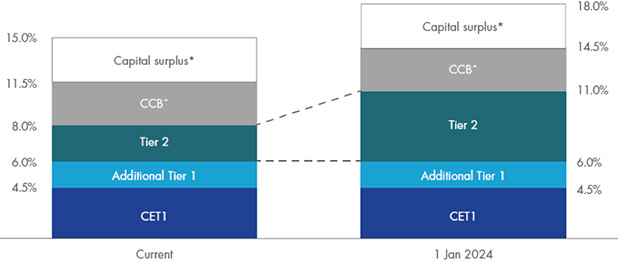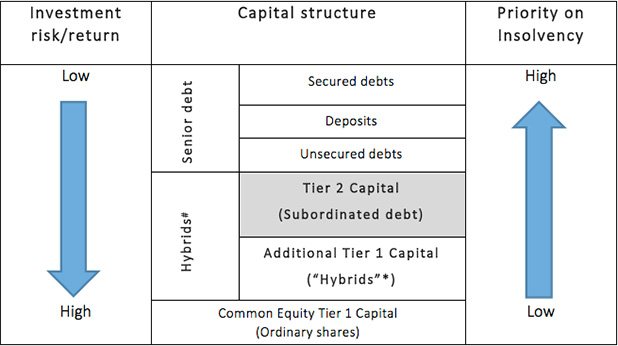How banks are changed forever
Although it’s been more than a decade, the fallout from the GFC continues to impact banks and how they raise capital. The most recent development in Australia is attracting a lot of attention and could provide an important opportunity for investors.
Find out about the new regulations from APRA (Australian Prudential Regulatory Authority) that require the big four banks to hold more regulatory capital, how this is likely to change the Australian fixed income universe and what investors can do to take advantage of these changes.
The financial crisis of 2008 led to the failures and bail-outs of many large global financial institutions, which were considered prior to that point as “too big to fail”. Lehman Brothers filed for bankruptcy on 15 September 2008. Merrill Lynch, AIG, HBOS and Royal Bank of Scotland were among the long list of financial institutions which were teetering on the brink of failure until the US Fed and other central banks around the world started bailing them out. Despite trillions of dollars being spent by governments, depositors and investors were spooked and there was a run on banks to withdraw savings. Borrowers disappeared, leading to plummeting property prices, increasing foreclosures, and share markets followed suit. The financial distress led to governments having to step in to rescue financial institutions and prevent a potential “breakdown in law and order”1.
In response to the fallout from the GFC, the Bank of International Settlements’ Basel Committee sought to redraft its universal standards. The new standards would ensure banks around the world could withstand unforeseen losses, unexpected withdrawals and reduce the likelihood that taxpayers would be forced to bail out large institutions again. Basel III, as it was known, was published in 2009, with an implementation deadline of 2019.
Basel III led to the concept of Total Loss Absorbing Capital (TLAC). TLAC is an additional layer of bonds that convert into equity capital once an institution’s debt capital reserves are depleted.
While each country drafted their own rules relating to Basel III and TLAC, Australia’s regulators took longer to decide on the specifics, mindful that credit rating agencies and global investors valued the implied government support given to Australia’s banks, which has helped lower their costs.
In July 2019, following a period of consultation, APRA decided that the major banks would need to significantly increase the minimum loss absorbing capital they hold. The intention is to boost their TLAC and minimise the risk of a systemically important bank failing and requiring taxpayer money to support a bail-out.
The new fixed income universe
Up until recently, Australia’s financial institutions had issued only modest amounts of what is called ‘Tier 2 Capital’, also known as ‘subordinated debt’. This is a particular category of debt securities that financial institutions can issue to raise total loss absorbing capital.
APRA’s new regulations require the major banks to more than double the amount of Tier 2 Capital they hold. It is estimated that Australia’s big four banks will need to raise a combined $50 billion of Tier 2 Capital over the next four years.
The chart below shows the expected increase in subordinated debt from the big four banks, which are considered Domestic Systemically Important Banks or ‘D-SIBs’. We note that there is currently no expectation of an increase in Common Equity Tier 1 Capital ('CET1') or Additional Tier 1 Capital (also known in the market as “hybrids”) being issued by the big four banks over the next four years.
Figure 1. Changes to major banks’ capital structures

Capital conservation buffer. *Capital surplus of 3.5% is generally higher than the level D-SIBs may normally maintain, as they have acted in anticipation of changes to the capital adequacy framework as a result of the ‘unquestionably strong’ capital benchmarks. APRA expects the D-SIBs to continue to maintain a normal capital surplus in excess of regulatory capital requirements once such changes are implemented. Source: ANZ.
How does subordinated debt work?
Subordinated debt has similar characteristics to traditional bonds, however in order to facilitate loss absorption, in times of financial stress it can be converted to shares or may be written off completely. It is called ‘subordinated’ because it sits below ‘senior debt’ or traditional bonds in the capital structure, but it also sits above and takes priority over ordinary shares, in the event of insolvency. See the shaded area in the chart below.
The following chart provides a simplified example of the capital structure in a financial institution to illustrate how different securities issued by financial institutions rank in priority of payment in the event of insolvency.
Figure 2. Simplified capital structure of a financial institution

#Per ASIC Report 365. *Per market convention.
You can see from the above chart that in the event of insolvency, priority is given to deposits and other senior debt. Shareholders get paid last, if at all.
Subordinated debt securities (also known as ‘subordinated bonds’) rank above ordinary shares and Additional Tier 1 Capital but below senior debt, including traditional bonds, deposits and unsecured debt obligations. For this reason, subordinated bonds carry more risk than deposits and traditional bonds but are considered less risky than shares and other hybrids.
Like traditional bonds, while the issuing financial institution is operating efficiently without financial stress, interest payments are made throughout the term of a subordinated bond and capital is repaid at maturity. Subordinated bonds are typically issued for 10 years and issuers often have an option to call the bond early after five years from maturity. However, in times of financial stress, unlike traditional bonds, subordinated bonds may stop making interest payments indefinitely and they can be converted to equity or written off without resulting in financial default which could trigger the collapse of the institution. This is because the purpose of Tier 2 Capital is that it can be absorbed to prevent the failure of systemically important financial institutions.
Since subordinated debt ranks below traditional bonds and above hybrids, it is therefore considered more risky than traditional bonds and less risky than hybrids2. As a result, financial institutions typically offer subordinated bonds with a higher interest rate than traditional bonds, but a lower interest rate than hybrids.
Reaction from banks
The banks had initially expressed concerns about the increase in size of the subordinated bond market due to APRA’s new Tier 2 Capital requirements because such a significant increase in issuance would potentially result in an increase in financing costs.
So far, the banks have been able to raise capital via subordinated bonds in both global and Australian markets without having to pay a materially higher cost than previously incurred. It is expected that the 4 year timeframe for compliance with the new Tier 2 Capital levels will also mitigate the banks’ concerns.
The opportunity
Until now, subordinated debt has primarily only been accessible by large institutions. Now investors of all sizes can access a subordinated debt portfolio.
With estimates that the big four collectively need to raise $50 billion in subordinated debt to meet APRA’s new Tier 2 Capital TLAC requirements by 2024, the subordinated bond market is poised for significant growth.
VanEck will be launching the VanEck Vectors Australian Subordinated Debt ETF (ASX: SUBD). The only one of its kind in Australia, SUBD will give investors access to a portfolio of investment grade subordinated bonds via a single trade on ASX. Subordinated bonds can offer attractive returns relative to other fixed income investments.
SUBD tracks the iBoxx AUD Investment Grade Subordinated Debt Index (SUBD Index) which only includes investment grade AUD denominated, floating rate bonds issued by financial institutions that qualify as Tier 2 Capital under APRA’s3rules.
1In 2018, Alistair Darling, who was the U.K.'s Chancellor of the Exchequer at the time, spoke out and stated that Britain came within hours of "a breakdown of law and order" the day that RBS was bailed-out.
2Please note: Although the term “hybrid” is used by ASIC to refer to both Tier 2 Capital and Additional Tier 1 Capital, this term tends to be used in the market (by advisers and the media) to describe only Additional Tier 1 Capital securities or ‘capital notes’. In this document, the word “hybrid” refers to Additional Tier 1 Capital securities or capital notes and “subordinated bonds” or “bonds” refers to Tier 2 Capital or subordinated debt.
3A reference to APRA in this context includes any equivalent foreign prudential regulatory body.
IMPORTANT NOTICE: This information is issued by VanEck Investments Limited ABN 22 146 596 116 AFSL 416755 (‘VanEck’) as the responsible entity and issuer of units in the VanEck Vectors Australian Subordinated Debt ETF ARSN 635 881 533 ASX Code: SUBD (‘SUBD’). This information is general advice only about financial products and is not personal financial advice. It does not take into account any person’s individual objectives, financial situation or needs. Before making an investment decision investors should read the product disclosure statement and with the assistance of a financial adviser consider if SUBD is appropriate for their circumstances. A copy of the PDS is available at vaneck.com.au or by calling 1300 68 38 37. SUBD is subject to investment risk, including possible loss of capital invested. Past performance is not a reliable indicator of future performance. No member of the VanEck group guarantees the repayment of capital, the payment of income, performance, or any particular rate of return from SUBD. SUBD is based on the iBoxx AUD Investment Grade Subordinated Debt Index (‘the Index’). The Index is the property of Markit Indices Limited (‘Markit’) and iBoxx® and Markit® are trademarks of Markit or its affiliates. The Index and trademarks have been licensed for use by VanEck. SUBD is not sponsored, endorsed, or promoted by Markit. VanEck® and VanEck Vectors® are trademarks of Van Eck Associates Corporation.
Related Insights
Published: 24 October 2019




